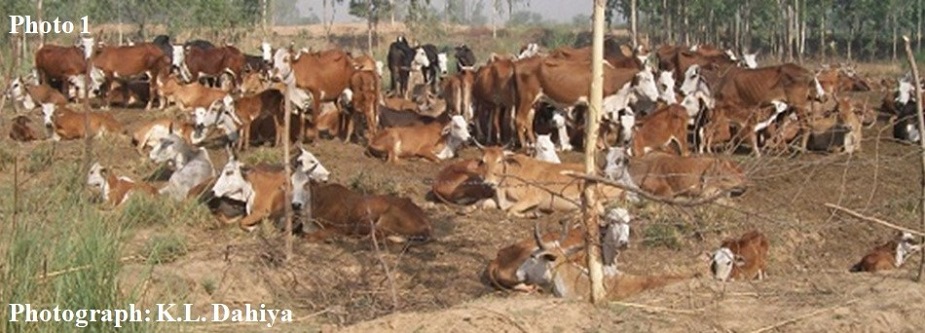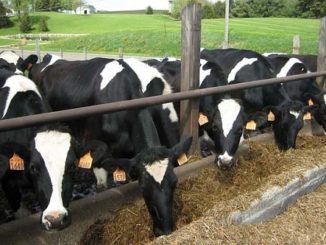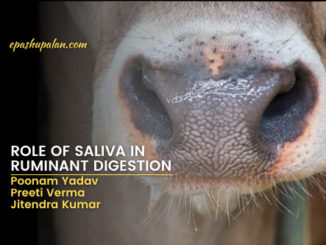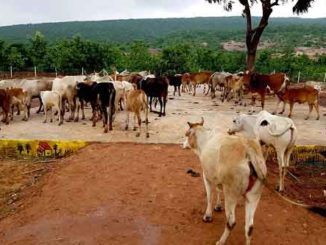Abstract
India is the home of unique cattle breeds of world which are well adapted to varied agro-climatic regions. The Indian cattle (Bos indicus) commonly known as Zebu cattle are well resistant to exotic diseases. They can thrive on least quality of grass and roughages. Among 41 identified and registered cattle breeds of India, ‘Belahi’ possess unique characters just like to other Indian cattle. They have reddish brown body, and white face and extremities and different degrees of white colour on ventral part of body. Some white body coloured variants may also be seen. They are hardy cattle, resistant to endo-ectoparasites and other contagious diseases and mastitis.
The livestock population in India includes cattle, buffaloes, sheep, goats, horses & ponies, camels, pigs, mules, donkeys and yaks (apart from poultry, dogs and rabbits), comprises 536.76 million (GOI 2019). In India, the cow is considered as a holy cow and worshipped by every Hindu. As per livestock census conducted in 2019, there are 193.46 million cattle heads in India which constitutes 26.04 percent of Indian livestock population (GOI 2019). There are 50 distinct registered breeds of cattle in India (NBAGR 2020) comprising 142.11 million indigenous cattle heads (GOI 2019). These indigenous described cattle breeds are well adapted across varied agro–climatic conditions of India. However, there is huge cattle genetic resource waiting for distinction in India, particularly the migratory cattle. It is also the fact that these non-descript cattle are playing most crucial role in securing livelihood and in the well-being of the traditional rural livestock farmers. It well documented that Indian cows (Bos indicus) are have unique morphological characters as compared to exotic (Bos taurus) one. Indian cattle are more summer heat tolerant as well better immunity against tick and and tick borne diseases including other exotic diseases.
Home tract
Among the Indian cattle, ‘Belahi’ is newly descriptive and registered breed with breed accession number INDIA_CATTLE_0532_BELAHI_03038 (Vohra et al., 2017). The home tract as well migratory tract of this breed is North Himalayan foothills commonly known as ‘Shivalik belt’ of Himalaya comprising the subdivisions Panchkula, Naraingarh and some parts of Ambala and Barara and Bilaspur of Panchkula, Ambala and Yamuna Nagar districts, respectively, of Haryana, India. There are more 20,000 cattle heads of Belahi in the Shivalik belt.
Adaptation
Belahi is distinct migratory cattle with a number of unique qualities related to better thriving and adaptation. It is well adapted for hot and humid climate and grazes more when the sunshine increases. It can thrive on very low quality of grass and roughage and produce high quality milk with least input cost.
Disease resistance
It has been observed that these cattle affect with any disease. It may be due to their genetic constitution as well as their grazing habits. It is least affected with contagious diseases particularly the Foot & Mouth Disease Virus (FMD). Though, there is least vaccination concerned even by the Belahi cattle keepers, never a single herd has been seen affected with FMD as whole. The animals kept at native home are regularly vaccinated against the foot & mouth disease virus, haemorrhagic septicaemia black quarter. They are also given anthelmintics as per need.
Rearing community
The Belahi cattle are reared by Gujjars migrating in the Shivalik foothills of Himalaya in Panchkula, Ambala and Yamuna Nagar districts of Haryana. These cattle are kept in herds of 100’s female with 2-3 bulls. The bulls are replaced every 3-4 years. The young calves are usually sold for agricultural purpose. Females are kept in herd and never sold. Because of high replacement, the livestock strength increases year by year.
The lifestyle of farmers and herding of animals
Being pastoralist, their life is totally associated with Belahi cattle. They are involved in cattle rearing round the year. They migrate along with their livestock from their native to a specific place. Around 8-9 months of the year, they remain outside from their home. Only for 3-4 months of winter, they and their cattle remain in respective native region after coming back from migration. At the time of festival particularly the Holi (in March), they start migration along with cattle towards specific areas particularly adjoining areas e.g. at Shahzadpur, Naraingarh, Saha blocks of Ambala districts, Sadaura and Bilaspur blocks of Yamuna Nagar in Haryana and Ropar in Punjab. Generally, they stay on wasteland area nearby the road and water reservoir (river or water body) and make a temporary hut for themselves and enclosure for animals (Photo 1). During migration, they cover around 50-60 kms on road from one side, which takes around 7-10 days to complete. They starts back journey in October and reaches respective home near Dipawali.

They migrate in groups of 5-6 people, preferably relative or known with a herd of 100-400 cattle heads. Only male members of the family stay away from home and ladies and children stay at home. Milking at around 6 AM and move for grazing around 8-9 AM and come back to the temporary halt at 5-6 PM, is their routine activity. The Local milkmen collect the milk after each milking. The animals are kept in temporary enclosures made of wooden trunks or bamboos. Thereby, animal owners also stay in shelter made nearby the animals. The small calves are kept in a separate enclosure. The small calves are also kept nearby the halt. At their native place, majority of cattle are housed in well-built house as a part of residence.
Most of the Belahi cattle breeders are illiterate or marginally literate. They remain in touch with each other for the betterment of the breed. Now, some of the officials are in touch with them, for the better livelihood of the farmers. They are going to form ‘Belahi Breeder’s Society or Trust’ so that they can raise their issues with high voice for the betterment of the Belahi breed cattle.
Feeding
These cattle are exclusively kept on grazing. Only some of the milch cows are provided concentrate feed at the time of milking.
Breeding
The breeding is performed only by purebred germplasm. The crossbreeding of artificial insemination in these cattle has never been allowed by the animal owners. They maintain and propagate pure Belahi cattle. The selected purebred young ones are reared properly for breeding purpose only.
Breed group
The Belahi cattle are dual i.e. milch (primarily) and draught purpose. The male young ones are sold for agriculture or draught purpose.
Breed Status
There are more than 20,000 cattle heads in the breeding tract. There, this breed needs conservation. There is continuous decline in pastures and water bodies in the native tract of this breed. The breed is under threat due to stray bulls of the breed particularly the exotic cow bulls during migration and non-resident halts. However, the breeders are continuously maintaining the purebred animals.
Morphological characteristics

- Body: Medium, symmetrical stature
- Body colour: Uniform but distinct body colour pattern having reddish brown body. Some animals grey or white
- Markings over body: White face and extremities and different degrees of white colour on ventral part of body.
- Skin: Soft and tight
- Head: Straight and broad with prominent poll.
- Forehead: Straight and broad forehead with prominent poll.
- Face: Slender
- Muzzle: Black
- Dewlap: Well developed and white
- Shoulder hump: Small to medium in size and is more prominent in males compared to females
- Naval flap: Well developed
- Horns: Medium sized, sickle shaped, curved upwards and inwards
- Tail: Long and fine with black switch in majority of cattle but white switch is also seen in some animals.
- Hooves: Black/greyish in colour
- Udder: Medium and round shaped properly placed udder with prominent milk vein
Morphomtric parameters
- Body weight: Birth weight 16 to 19 kg in male and 14 to 17 kg in females; Male: 305 kg; Females: 267 kg
- Height at withers: Male: 131.13 cm, female: 120.33 cm
- Body length: Male: 124.5 cm, female: 116.67 cm
- Horn length: Male: 27.2 cm, female: 25.4 cm
- Average heart girth: Male: 162.71 cm, female: 157.17 cm
Reproductive traits
In Belahi cows, age at first calving varies from 30 to 46 months with an inter-calving period of 12 to 15 months.
- Age at first calving: 30 – 46 months
- Inter-calving period: 12 – 15 months
- Service period (days): days after calving till conception
Production traits
Normally, the recently calved cows yield 3-4 kg of milk which increases gradually up to 5-6 kg per day. The average daily milk yield in Belahi cattle were recorded as 3.25 kg, which is higher than the national average daily milk yield (2.14 kg) reported for indigenous cattle (Vohra et al., 2016).
The milk recording data of some lactating Belahi cows was conducted maintained by the author(s) in May 2012, with the help of Dr. Vikas Vohra, scientist at NBAGR, Karnal. The milk yield was note between 3.0 to 8.16 kg per day. Among these animals, 75 per cent cows yielded 5.1 to 8.16 kg milk per day.
The highest milk yield (more than 9 kg per day) received during the rainy season of July, when there is ample green fodder in the pastures or open land. During the last 2-3 months of pregnancy, cows are kept dry. The milk fat content of this of varies from 2.37 – 7.89%. The pooled milk contains 14.38% total solids, 5.25% fat, 3.45% protein and 5.20% lactose, indicating good quality of the milk.
The bullocks are used as draught power in the adjoining lower hills of Shivalik areas.
Behaviour of the animals
As these animals are migratory in nature and are kept open without stanchions, are considered as furious by other than breed owners. However, the temperament of these cattle is variable ranging from moderate to furious.
Milk and milk by-products
The farmers sell the fresh milk to local milkmen at genuine price. Now, it is well acquainted that the ‘Belahi Cow’ an open pastures grazing cow without supplementing the sufficient concentrate feeds. These animals survive solely on the pasture lands, what-so-ever grown naturally. Therefore, there are least chances of pesticide or herbicide residues in their milk. It means that milk produced by this cow is toxin free which is good for the human health. Moreover, the Belahi milk is A2 milk as other Indian cows which have been proposed well for health (Kirk et al., 2017).
Now, the farmers are fetching a good price of rupees 70 per kg of milk in the adjoining urban population. The author(s) are supporting the ‘Belahi Cow’ breeders to sell milk and milk by-products among the urban population. The clarified butter (deshi ghee) has been sold at a good price of rupees 1500 per litre.
Promotion by the Government
The Animal Husbandry & Dairying Department, Panchkula, Haryana launched a scheme for the conservation and development of indigenous cattle (Gausamvardhan). The motive of this scheme is to identify top quality germplasm for sustainable genetic improvement; procurement of pedigreed young indigenous bulls (male calves) for further supply in the State/Country and encouraging the farmer to rear better yielding Belahi cattle. The Haryana Government is also providing the incentives to the Belahi cow owner whose cows are yielding more than 5 kg milk per day. They are awarded with cash incentive as Rs. 5,000, 10,000 and 15,000 to those whose Belahi cows are yielding 5-8, 8-10 and above 10 kg milk per day, respectively (DAHD 2020).
References:
- DAHD, 2020-21, Scheme for the conservation and development of indigenous cattle (Gausamvardhan) 2020-21, Department of Animal Husbandry & Dairying, Haryana – India. [Web Reference]
- GOI, 2019, 20th Livestock Census–2019, All India Report. Govt. of India. Ministry of Fisheries, Animal Husbandry & Dairying. Department of Animal Husbandry & Dairying. Animal Husbandry Statistics Division. Krishi Bhawan, New Delhi. [Web Reference]
- Kirk B., et al., 2017, “A2 Milk Enhances Dynamic Muscle Function Following Repeated Sprint Exercise, a Possible Ergogenic Aid for A1-Protein Intolerant Athletes?,” Nutrients; 9(2): 94. [Web Reference]
- NBAGR, “BELAHI CATTLE,” National Bureau of Animal Genetic Resources Karnal-132001 (Haryana) [Web Reference]
- NBAGR, “REGISTERED BREEDS OF CATTLE,” ICAR- National Bureau of Animal Genetic Resources (NBAGR); assessed on December 13, 2020. [Web Reference]
- Singh S.P., Tiwari M. and Sharma D., 2015, “Untapped genomic diversity of Indian cattle for sustainable milk Production,” Directorate of Extension and Department of Veterinary Physiology on behalf of UP Pt. Deen Dayal Upadhyaya Pashu Chikitsa Vigyan Vishwavidyalaya Evam Go-Anusandhan Sansthan (DUVASU), Mathura – 281001, U.P. (India): 113. [Web Reference]
- Vohra V., 2012, “Breed Saviour Awards 2012 – LIVESTOCK KEEPERS’ PROFILE,” edited by P. Vivekanandan and Dr. D.K. Sadana, Published by Sustainable-agriculture & Environmental Voluntary Action (SEVA): 45 – 49. [Web Reference]
- Vohra V., et al., 2014, “Belahi: Cattle Pastoralism in the Himalayan Foothills,” Proc. Aust. Soc. Anim. Prod.; 30: 317. [Web Reference]
- Vohra V., et al., 2016, “Phenotypic characterization, management and performance of Belahi cattle,” The Indian Journal of Animal Sciences; 86(3): 355-358. [Web Reference]
- Vohra V., et al., 2017, “Characterization of rare migratory cattle and evaluation of its phylogeny using short-tandem-repeat-based markers,” Journal of Applied Animal Research 45(1): 355-363. [Web Reference]
- Vohra V., Niranjan S.K. and Joshi B.K., 2012, “Belahi cattle: uniform but distinct germplasm of Haryana,” Journal of Animal Research, 2(1): 47-51. [Web Reference]







Be the first to comment